
Consider the circuit shown in Figure P7.32. The transistor parameters are
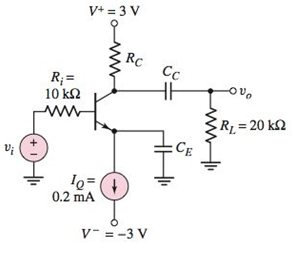
Figure P7.32
(a)
The value of
Answer to Problem 7.32P
The value of collector resistor,
Explanation of Solution
Given:
The given circuit is shown below.
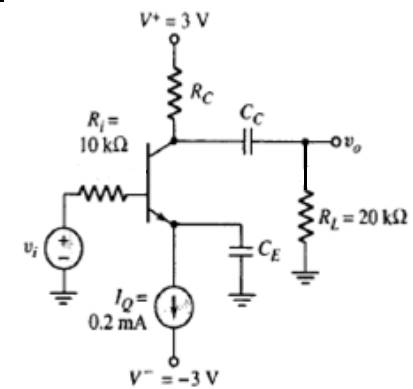
Calculation:
From figure, the value of emitter current is,
The value of base current is,
Substitute
The value of collector current is,
Substitute
The value of emitter voltage is,
Substitute
The value of collector voltage is,
Substitute
The value of collector resistor is,
Substitute 3 V for
(b)
The mid band gain
Answer to Problem 7.32P
The value of mid-band gain
Explanation of Solution
Given:
The given circuit is shown below.
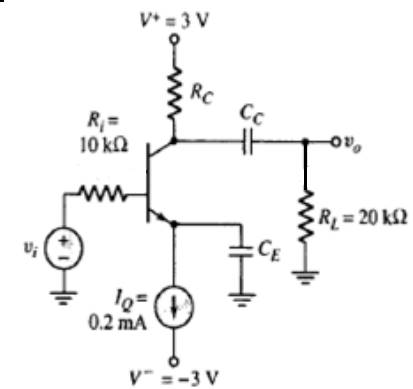
Calculation:
Draw the small signal equivalent circuit of figure to derive expression for mid band gain.
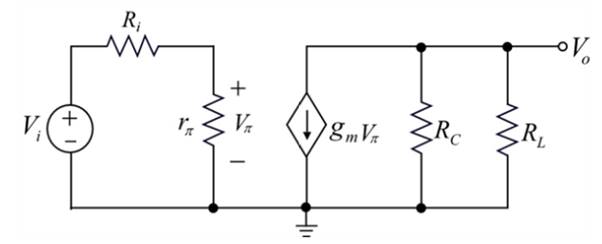
Apply voltage division rule to calculate the voltage across the base input resistor associated withthe input portion of the circuit.
Apply Kirchhoff's current law at output node in Figure 1
Substitute
The value of base input resistance.
Substitute
The value of transconductance is,
Substitute
The value of mid-band gain is,
Substitute
for
(c)
To derive: The expression for the corner frequencies associated with
Answer to Problem 7.32P
The expression for the corner frequency associated with
The expression for the corner frequency associated with
Explanation of Solution
Given:
The given circuit is shown below.
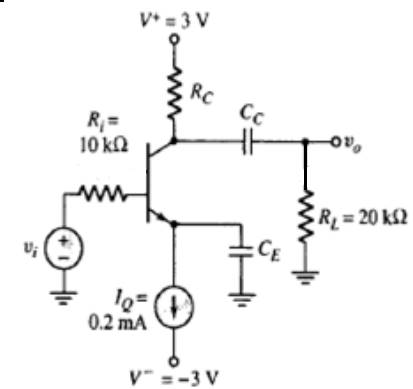
Calculation:
Derive the expression for the comer frequency associated with
Thus, the expression for the corner frequency associated with
Derive the expression for the comer frequency associated with
Thus, the expression for the corner frequency associated with
(d)
The value of
Answer to Problem 7.32P
The value of capacitance,
The value of capacitance,
Explanation of Solution
Given:
The given circuit is shown below.

Calculation:
Determine the value of capacitance,
Substitute
Thus, the value of capacitance,
Determine the value of capacitance,
Substitute
Thus, the value of capacitance,
Want to see more full solutions like this?
Chapter 7 Solutions
MICROELECT. CIRCUIT ANALYSIS&DESIGN (LL)
- The E-field pattern of an antenna. independent of , varies as follows: E 0 0° ≤ 0≤ 45° 45°<≤ 90° 90° <8180° (a) What is the directivity of this antenna? Umax 7 why did we use this law Umax = 12 but we divided by 2? In the sent Solution = R 27arrow_forwardThe normalized far-zone field pattern of an antenna is given by (sin cos²) E = 0 00 and 0 ≤ ≤ π/2. 3/22 π elsewhere Find the directivity using (a) the exact expression In the sent soalation Use Prad=2+1 7/2 Pre= 2 + 1 Sco³odo + 5 siño de Where did the 2 Com from?arrow_forwardPen and paper solution please with explaination not using chatgptarrow_forward
- howarrow_forwardA four pole generator having wave wound armature winding has 51 slots ,each slot containing 20 conductors,what will be the voltage generated in the machine when driven at 1500rpm assuming the flux per pole is 7mWb Don't use Artificial intelligencearrow_forwardNeed Handwritten solution Do not use chatgpt Or AIarrow_forward
- I need a detailed solution to a problem. The far-zone electric field intensity (array factor) of an end-fire two-element array antenna, placed along the z-axis and radiating into free-space, is given by E=cos (cos - 1) Find the directivity using (a) Kraus' approximate formula (b) the DIRECTIVITY computer program at the end of this chapter Repeat Problem 2.19 when E = cos -jkr 0505π $[ (cos + 1) (a). Elmax = Cost (case-1)] | max" = 1 at 8-0°. 0.707 Emax = 0.707.(1) = cos [(cose,-1)] (cose-1) = ± 0,= {Cos' (2) = does not exist (105(0)= 90° = rad. Bir Do≈ 4T ar=2() = = Bar 4-1-273 = 1.049 dB T₂ a. Elmax = cos((cose +1)), 0.707 = cos (Close,+1)) = 1 at 6 = π Imax (Cose+1)=== G₁ = cos(-2) does not exist. Girar=2()=π. 4T \cos (0) + 90° + rad Do≈ = +=1.273=1.049dB IT 2arrow_forwardI need an expert mathematical solution. The E-field pattern of an antenna. independent of , varies as follows: 0° ≤ 0≤ 45° E = 0 45° {1 90° 90° < 0 ≤ 180° (a) What is the directivity of this antenna? (b) What is the radiation resistance of the antenna at 200 m from it if the field is equal to 10 V/m (rms) for Ø = 0° at that distance and the terminal current is 5 A (rms)?arrow_forwardI need an expert mathematical solution. The normalized far-zone field pattern of an antenna is given by E = {® (sin cos)/ 0 Find the directivity using 0 ≤ 0 ≤ π and 0≤ 0≤ π/2. 3m2sds2, elsewherearrow_forward
- I need an expert mathematical solution. The radiation intensity of an aperture antenna, mounted on an infinite ground plane with perpendicular to the aperture. is rotationally symmetric (not a function of 4), and it is given by sin (7 sin 0) U π sin Find the approximate directivity (dimensionless and in dB) usingarrow_forwardWaveforms v1(t) and v2(t) are given by:v1(t) = −4 sin(6π ×10^4t +30◦) V,v2(t) = 2cos(6π ×10^4t −30◦) V.Does v2(t) lead or lag v1(t), and by what phase angle?arrow_forward7.1 Express the current waveform i(t) = -0.2 cos(6 × 10°1 +60°) mA in standard cosine form and then determine the following: (a) Its amplitude, frequency, and phase angle. (b) i(t) at t=0.1 ns.arrow_forward
 Introductory Circuit Analysis (13th Edition)Electrical EngineeringISBN:9780133923605Author:Robert L. BoylestadPublisher:PEARSON
Introductory Circuit Analysis (13th Edition)Electrical EngineeringISBN:9780133923605Author:Robert L. BoylestadPublisher:PEARSON Delmar's Standard Textbook Of ElectricityElectrical EngineeringISBN:9781337900348Author:Stephen L. HermanPublisher:Cengage Learning
Delmar's Standard Textbook Of ElectricityElectrical EngineeringISBN:9781337900348Author:Stephen L. HermanPublisher:Cengage Learning Programmable Logic ControllersElectrical EngineeringISBN:9780073373843Author:Frank D. PetruzellaPublisher:McGraw-Hill Education
Programmable Logic ControllersElectrical EngineeringISBN:9780073373843Author:Frank D. PetruzellaPublisher:McGraw-Hill Education Fundamentals of Electric CircuitsElectrical EngineeringISBN:9780078028229Author:Charles K Alexander, Matthew SadikuPublisher:McGraw-Hill Education
Fundamentals of Electric CircuitsElectrical EngineeringISBN:9780078028229Author:Charles K Alexander, Matthew SadikuPublisher:McGraw-Hill Education Electric Circuits. (11th Edition)Electrical EngineeringISBN:9780134746968Author:James W. Nilsson, Susan RiedelPublisher:PEARSON
Electric Circuits. (11th Edition)Electrical EngineeringISBN:9780134746968Author:James W. Nilsson, Susan RiedelPublisher:PEARSON Engineering ElectromagneticsElectrical EngineeringISBN:9780078028151Author:Hayt, William H. (william Hart), Jr, BUCK, John A.Publisher:Mcgraw-hill Education,
Engineering ElectromagneticsElectrical EngineeringISBN:9780078028151Author:Hayt, William H. (william Hart), Jr, BUCK, John A.Publisher:Mcgraw-hill Education,





